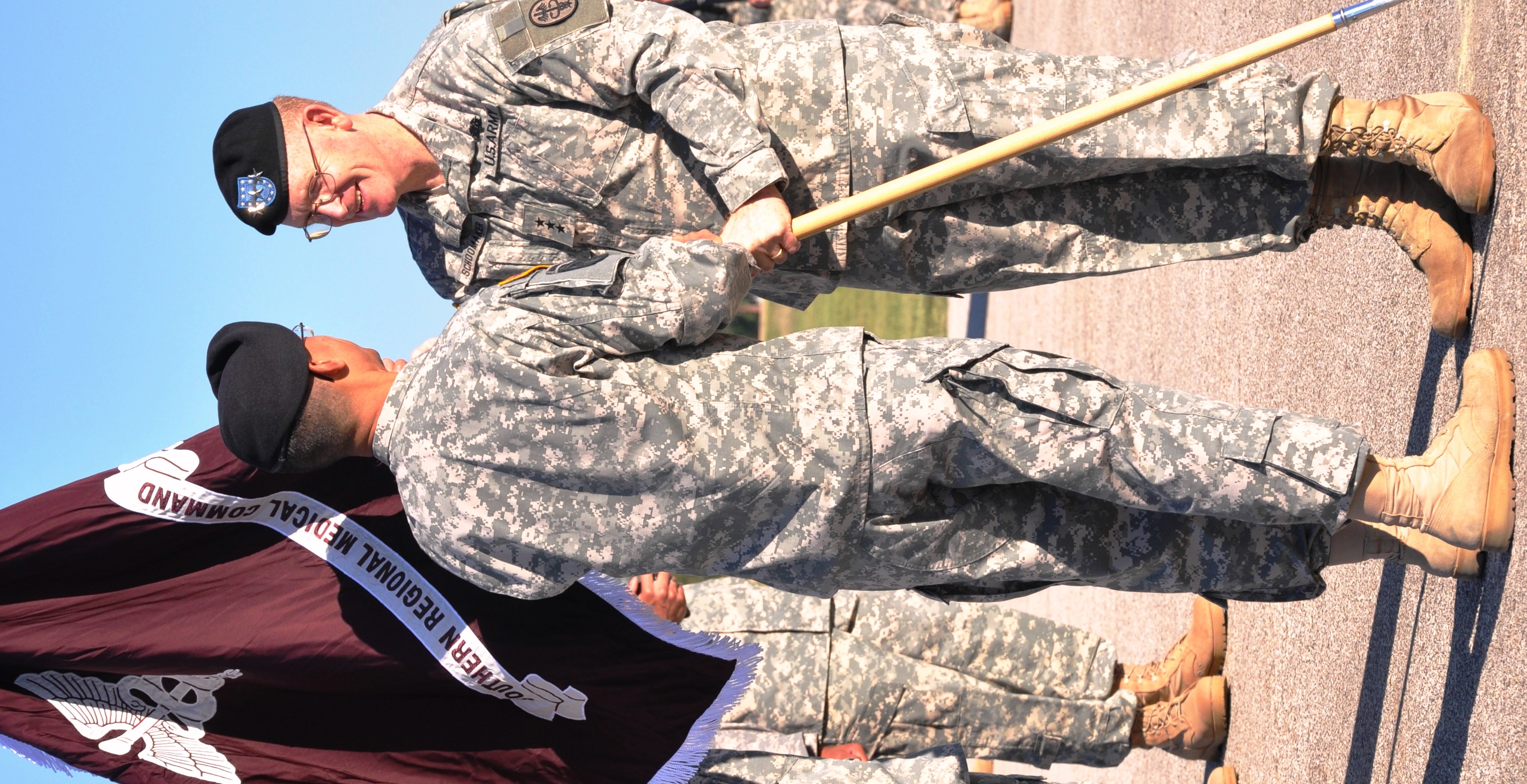FORT SAM HOUSTON, Texas -- In a move designed to better serve the Army of the 21st century, the Southern Regional Medical Command was activated during a ceremony at the MacArthur Parade Field Oct. 8. At the same time, the Southeast Regional Medical Command and Great Plains Regional Medical Command were inactivated and their colors retired.
The SRMC is now the key operational element for Army medicine covering an area encompassing 11 states and one territory.
Lt. Gen. Eric B. Schoomaker, commanding general of the U.S. Army Medical Command, directed realignment of the regional medical commands Oct. 1, 2009. The SRMC merges four medical treatment facilities from the Great Plains Regional Medical Command and seven MTFs from the Southeast Regional Medical Command.
"This is of great significance to Army medicine," Schoomaker said during the ceremony. "It is the single largest reorganization we have had since 1997 and sets the stage for substantial improvements in care for our units and beneficiaries."
"This is the culmination of 18 months of work to better meet the needs of our units and beneficiaries," said Brig. Gen. Joseph Caravalho Jr., who in addition to commanding Brooke Army Medical Center, will also be commanding general of the SRMC's 10 Army hospitals, numerous health clinics and centers and all Community Based Warrior Transitions Units. He was formerly the commanding general of the Great Plains RMC.
The Great Plains RMC dates back to the BAMC Health Service Region in 1991, which evolved into the South Central Health Service Support Area in 1993. In 1995, the Fitzsimmons HSSA (based in Boulder, Colo.) was dissolved and the majority of states and MTFs west of the Mississippi River migrated into the South Central HSSA.
HSSAs underwent a name change in 1996 at the suggestion of a former Army Chief of staff and became regional medical commands. In 1997, the final two MTFs were transferred from the Southwest MRC as part of its inactivation, leaving a GPMRC comprised of 10 primary MTFs, supporting four divisions, across a 16-state area of responsibility.
The Southeast RMC was established in July 1996 to serve more than 2 million beneficiaries throughout the southeastern United States and Puerto Rico. Headquartered at Fort Gordon, Ga., the command provided command and control for Soldiers and beneficiaries at 19 medical centers, hospitals, clinics and training areas.
"A new era for the Army Medical Command starts now," said Brig. Gen. W. Bryan Gamble, formerly the Southeast MRC commanding general. He will now serve as deputy commanding general of SRMC for readiness and commanding general of Dwight D. Eisenhower Army Medical Center at Fort Gordon. "It's a privilege and honor to be part of Army history."
The SRMC will encompass BAMC, Eisenhower, Carl R. Darnell Army Medical Center (Fort Hood, Texas), Winn Army Community Hospital (Fort Stewart, Ga.), Blanchfield Army Community Hospital (Fort Campbell, Ky.), Moncrief Army Community Hospital (Fort Jackson, S.C.), Lyster Army Health Clinic (Fort Rucker, Ala.), Reynolds Army Community Hospital (Fort Sill, Okla.), Baynes-Jones Army Community Hospital (Fort Polk, La.), Martin Army Community Hospital (Fort Benning, Ga.) and Fox Army Health Center (Redstone Arsenal, Ala.).
Also included in the SRMC are the U.S. Army Aeromedical Center (Fort Rucker, Ala.), Rodriguez Army Health Clinic (Puerto Rico), Southern Command Clinic (Miami, Fla.), Community Based Warrior Transition Units (at Fort Sam Houston and in Arkansas, Alabama, Florida and Puerto Rico), and additional clinics in Alabama, Arkansas, Mississippi and Oklahoma.
"What you see here today is representative of more than 18,000 Soldiers and thousands and thousands of civilians," Schoomaker said. "I take enormous pride in both former commands. We needed this realignment to improve services and better support our installations, Soldiers and beneficiaries and align better with TRICARE civilian hospitals."




Social Sharing